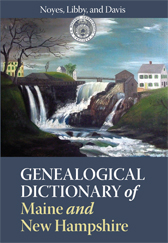 For more than seventy years the Genealogical Dictionary of Maine and New Hampshire – compiled by Charles Thornton Libby, Walter Goodwin Davis, and Sybil Noyes, and published between 1928 and 1938 – has been the first recourse for those looking to trace their seventeenth-century northern New England ancestry. It is one of a handful of titles in the genealogical field that has never been out of print for very long.
For more than seventy years the Genealogical Dictionary of Maine and New Hampshire – compiled by Charles Thornton Libby, Walter Goodwin Davis, and Sybil Noyes, and published between 1928 and 1938 – has been the first recourse for those looking to trace their seventeenth-century northern New England ancestry. It is one of a handful of titles in the genealogical field that has never been out of print for very long.
The compilers’ aim was this: to document the lives and families of all the area’s inhabitants who settled there by 1699, with three generations of their descendants. Its nearly eight hundred pages of incredibly dense (but never uninteresting) text are brimming not only with the basic genealogical facts of our ancestors’ lives, but also the records that illustrate, sometimes graphically, their human side as well. For example, about Philip Chesley of Oyster River, New Hampshire, we are told that “his and his 2d wife’s share of existing records would fill a ‘movie,’ an alternating current of honor[able] and impuls[ive] activ[ities].” Of John Hart, shipwright, of Portsmouth, and his wife Ann, we learn that “Geo. Jones fought with him . . . and gave Ann a black eye, 1662.” And we learn the following of Hubertus Mattoon: “devoted to women, he m[arried] at least three. . . . In June 1673 he m[arried] one equally devoted to men, Sarah (Pearce) Jones, whose husb[and] was living and undivorced. Mattoon divorced her in 1682, when she confessed misconduct, accusing him of the same and of desertion above 7 y[ea]rs.” Clearly, our ancestors’ lives were not dull.
The Dictionary contains hundreds of thousands of statements of fact and of judgment. Its greatness derives from its comprehensiveness. It represents one of the most thorough and exhaustive studies of an entire population ever undertaken. Rather than rely on earlier, uncritical secondary sources, the compilers dispassionately sifted and collated a wealth of primary sources to document both the great and the obscure. By looking at the whole picture and not just individual families, they were able to see patterns, make connections, and reach conclusions that had eluded their predecessors. This democratic approach to genealogy was a hallmark of the early twentieth-century disciples of Donald Lines Jacobus, who shunned the biases of mere ancestor-hunting in favor of a more rigorous methodology, and that had applications to the studies of populations and of history itself. The genealogist Danny D. Smith has written that “the Dictionary is a pioneer model population study, invaluable to demography, sociology, and the related social sciences.”
There is no doubt that the Dictionary is a triumph of genealogical scholarship. For many of the subjects of the book’s sketches, it remains today the only source in which their names appear in print. With this new printing, the Genealogical Dictionary of Maine and New Hampshire is once again accessible to a new generation of genealogists.
Adapted from the foreword to the new NEHGS edition of Libby, Davis, and Noyes’ Genealogical Dictionary of Maine and New Hampshire.
Been trying to find where Daniel Curtis, 1738-1829 came from, He settled in Pemaquid, Maine. Very interested in this book but can it help me in finding out who Daniel was and where he came from?
The Genealogical Dictionary of Maine and New Hampshire is really focused on the seventeenth century. Curtis heads of family covered in the book are Henry of Sheepscot (seen in Boston 1666/67), Henry of Sagadahoc (seen there in 1674), John (seen in Dover in 1657/58), John of Marblehead (in 1681), John of York (children born 1718-31), Joseph of Kittery (by 1683), Mary (aged 36 in 1725), Ralph (seen in 1681), Thomas (of York ca. 1642; his children are covered into the 1700s), Thomas (of Kennebec in 1688), William (of Dover in 1650), and William (mariner of the Isle of Shoals in 1686).
Does the book mention James Blagdon of Isle of Shoals? I found a reference to him: “… at ye Ysland of Shoals bot a cable and anker of John Wilde of Massachusetts” . Thank you.
Any Ferren/Ferrin/Farrin families in there. I know some of Jonathan Farren’s descendants went to Maine to settle.
Thomas Farrand is briefly noted.
I, too, am very interested in this book, having Phelps ancestors; and forever have been looking for a Cummins family who had settled in the Windsor VT area by 1814 – any such mentions in there?
Thank you kindly for the reference to my ancestor, Hubertus Mattoon, who certainly seems to have…gotten around.
How are you related to the Mattoon’s? Hubertus is my 8th great-grandfather. Elsie Grace Mattoon was my great-grandmother on my maternal side.
Very interesting. A question of origin: Hubertus Mattoon was born in Scotland?